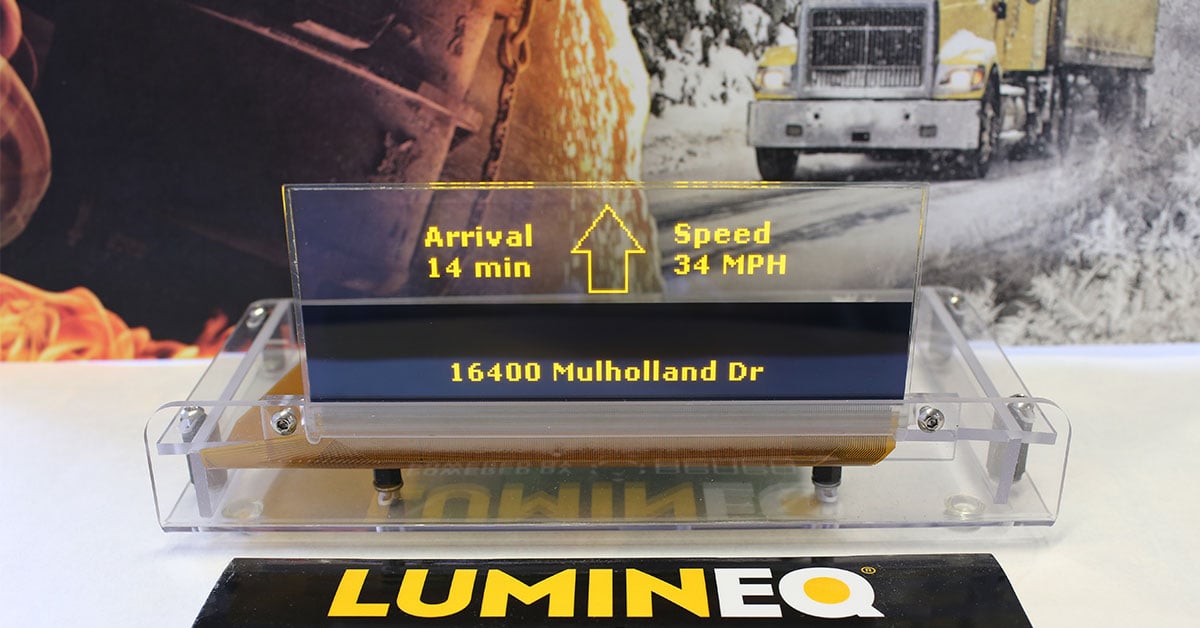LUMINEQ products are Thin Film Electroluminescent (TFEL) displays, not OLED nor LCD. Our displays are inorganic design and emit lights themselves.
Our displays comprise a solid-state glass panel, an electronic control circuit, and a power supply. The glass panel, the heart of the assembly, consists of a luminescent phosphorous layer sandwiched between transparent dielectric layers and a matrix of row and column electrodes.
The circuit board, which contains the drive and control electronics, is connected directly to the back of the glass panel. A pixel on the display is lit by applying voltage to the row and column electrodes, thus causing the area of the intersection to emit light.
For more information about TFEL technology, please visit our Technology page.
The transparency of LUMINEQ displays is 80% as stand-alone, and 70% when laminated in glass or polycarbonate. Micro displays have over 90% transparency with excellent clarity and minimum haze.
All of the LUMINEQ product lines offer demo products. The list of demo products can be found from our Transparent Displays, Transparent Touch Displays and Transparent Micro Displays page. You can request a quote on any of the individual demo product page or on the Contact us page.
The operating lifetime of LUMINEQ displays is over 20 years. 85% of original brightness remains after 100 000 hours of usage.
LUMINEQ displays are inorganic solid-state design. So their lifetime is not affected by the external environments such as temperature and humidity.
We offer displays with active area up to 240 x 180 mm. It is possible to use multiple displays together, depending on the final design.
The operating temperature range of LUMINEQ displays is from -60 °C to 105 °C (-76°F to 221°F). Instant-on regardless of temperature. Since they are inorganic design, the performance is not affected by the temperature, so they are perfect for extreme conditions.
We have two different phosphors currently; a yellow and green. For outdoor use we recommend yellow as it is by default brighter. For indoor use or with tinted background applications green is also possible.
Using LUMINEQ in-glass/polycarbonate laminated displays for HUD simplifies the setup and saves space, and doesn't have viewing angle limit.
A typical HUD uses a projector system to project the information to the windshield in front of the driver. It contains three primary components: a projector, a combiner, and a video generation computer. While this complicated setup works for cars, it occupies valuable space in the car with a strict requirement for the projection angle. Moreover, it doesn't work for vertical windshields in buses, trucks, or industrial vehicles.
We offer a simpler solution. By laminating a thin-film transparent display in glass or polycarbonate, the information can be shown directly on the windshield without any extra setups. It saves space and may also bring the cost down.
Yes. We can utilize the same thin film layers to embed a touchscreen functionality. The touch sensors are integrated directly in the functional display layer. So no additional touch layer is required.
Yes. LUMINEQ touch technology has been engineered to work in the rain and in extreme temperatures.
Interface is customizable. Typically our displays support standard interfaces like RS485, I2C, CAN and NMEA.
The size of the electronics depends on the size of the display, the complexity of the design, and the desired brightness. Giving a couple of examples, our standard boards are 79 x 50 mm (3.11” x 1.97”) and 105 x 35 mm (4.13” x 1.38”). The board size typically goes with the display
content versatility.
Bending radius 1200 mm (47.2”) or greater is possible during the lamination process.
LUMINEQ transparent segmented displays have over 80% transparency and matrix 70%. When the segmented display is laminated in glass, the transparency is 70%.
We use glass as a substrate material.
For the lamination purpose we use 0.7 mm (0.028") glass.
For the stand-alone solution it is normally 1.1 mm (0.043") glass + cover glass. The cover glass thickness is customizable. We have been using typically 0.4 - 4 mm (0.016"- 0.16") cover glasses.
LUMINEQ transparent displays have a 360° viewing angle without polarizers. They work with all the sunglasses.
When properly laminated in glass, LUMINEQ display is fully protected and the ruggedness is excellent. The technology is inorganic and solid-state, which makes LUMINEQ the most durable display type in the market.
Yes, we can implement a frame rate and/or voltage-based dimming methods.
With a proper impact resistance design like lamination into polycarbonate is a feasible application. Check out our customer case Honda racing motorcycle.
Chrome patterns can be used as traditional crosshair, which will be visible when display is off. Chrome behind the segments also nearly doubles the brightness.
Our displays are monochrome. Yellow is our brightest color, but we can also make green.
There is a marginal difference between sections with and without ITO.
Currently the minimum size is 10µm. We are working to support smaller details.
Typically needed space is 10µm.
Typical frame rate is around 500 fps.
Yes, we have four types of demo kits with 10 µm and 20 µm crosshair thickness with and without traditional chrome crosshair. Check out our reticle demonstrator ELT32S-RETICLE-BAT product page.
Interface is customizable. Typically our displays support standard interfaces like I2C.
Yes. We've done projects for customers who wanted to combine transparent and non-transparent displays for the same application. See the demo image below.

It depends on the complexity of the display design. The typical development time of a custom display is 12-14 weeks. To start, you may request a custom display by submitting a form. The more information you provide to us regarding your project and design requirements, the more likely we can create a suitable proposal for you.
Subscribe to our newsletter and get updates on the latest display technologies and industry trends.